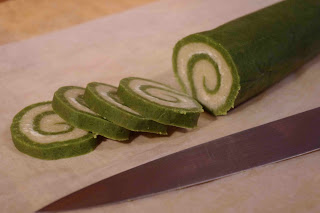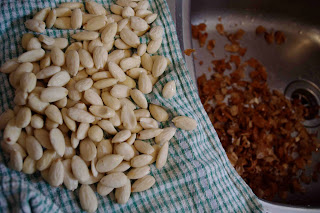I noticed these in the Ottolenghi cookbook last weekend when I made eight of its dishes including the Parmesan and poppy biscuits on the facing page to these, which is a story for another day. These are the sort of thing for which one always has the ingredients, for a change. And they’re pretty good, even without the dip one has failed to procure for Friday-night office wine.
Adapted from Ottolenghi: the Cookbook, p186
250g plain flour (I used 100g each of plain and bread flour, and 50gm wholemeal flour)
1 tsp baking powder
115ml water
25ml olive oil, plus extra for brushing (I used extra virgin)
½ teaspoon salt
1 teaspoon paprika
1/2 tsp cayenne
¼ teaspoon black pepper
course sea salt for sprinkling – I found Maldon a bit too coarse on the first tray’s worth, so ground normal salt over the rest
1 tsp baking powder
115ml water
25ml olive oil, plus extra for brushing (I used extra virgin)
½ teaspoon salt
1 teaspoon paprika
1/2 tsp cayenne
¼ teaspoon black pepper
course sea salt for sprinkling – I found Maldon a bit too coarse on the first tray’s worth, so ground normal salt over the rest
Combine all the ingredients except the sea salt in the mixer bowl, and knead it with the dough hook until it all comes together in a firm consistency. (Or do it by hand.) Wrap in cling film and leave it to rest for an hour in the fridge.
Preheat the oven to 220°C. On a well-floured surface, use a rolling pin to roll walnut-sized bits of the dough as close to paper-thin as possible – or at least attempt this for one long, oval ‘witch’s tongue’, feel despairing at the result, have a brainwave and GET OUT YOUR PASTA MACHINE!
 |
| It really does look like a sulphurous witch's tongue... |
Oh, it’s so inexpressibly pleasing when I find an unexpected use for such a guilt-provokingly underutilised utensil as the Imperia Tipo Lusso SP150. Putting the bits of dough through the largest setting and then the second-or-third-smallest to produce perfect thinness was the easiest task in the world, even though I’ve carelessly lost the attachment that bolts the machine to a benchtop, so that most of my left hand was employed holding the machine down while a few leftover fingers had to elevate the dough as it fed through the rollers.
Lay the pieces on trays lined with baking paper, brush generously with olive oil, then sprinkle on the sea salt, or topping of your choice – I tried fennel and cumin seeds for the third tray. Next time I might try chopped rosemary or thyme.
Bake for about 6 minutes, until crisp and golden brown. Allow to cool and store in an airtight container.



































